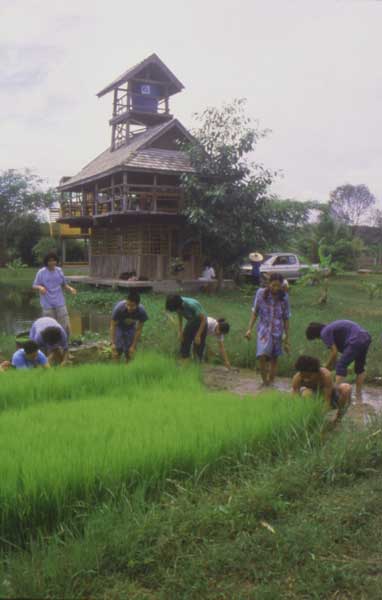Abstract
The land project was initiated by Rirkrit and Kamin Letchaiprasert as a self-sustaining environment emerging from the artistic community. The land is located in the northern part of Thailand, near the village of Sanpathong, 20 km southwest from the provincial city of Chiang Mai. It is intended to be cultivated as an open space or community free from ownership, with elements favoring discussions and experimentation in the fields of culture. The land is open to the day-to-day activities of local living (i.e. the growing of rice) and to the neighboring community. On the social field of the land, artistic practices are discussed and tested. This project, a hybrid of innovation and traditionalism, contrasts contemporary materials and technologies with ancient forms of agriculture.
While the land is a rice field and a garden, freely accessible to all, it also supports architectural constructions that may be utilized in variety of ways, from shelters for sleeping to kitchens for cooking to platforms from which to deliver lectures or performances. A number of artists and architects are involved in this aspect of the land's potential, though participation is not confined solely to those in the arts. The people who have contributed to the land's structure so far have come from both local and international artistic backgrounds, with artists such as: Kamin Letchaiprasert, Mitr Jai Inn, Tobias Rehberger, Philippe Parreno, Francois Roche, Angkrit Ajchariyasophon, Prachaya Phinthong, the artist group SUPERFLEX and Tiravanija. These small constructions vary from outhouses collecting biogas which is later converted for cooking, to kitchens and a central hall with generator powered by elephants' movements, to living (meditation) huts are designed and built as artistic and architectural experiments, although they also function as spaces which artists, students, and farmers alike can utilize. Because the land is empty of expectation, it is truly open to possibility, and in this openness, science, architecture, art, religion, technology, and the environment all play a part in determining the design and function of the space. In a sense, it is through this complete lack of determination that so many experiments, and discoveries are engendered: emptiness as an incubator, of sorts.
Anyone may build a new structure on the land with the only condition being that the addition remain accessible to all, as is the goal of the land generally. We provide the land and commit to care-taking and repairs of the buildings that are to remain on the land on a permanent basis, but encourage each artist to raise the funding for the actual construction. Rirkrit's own structure, as well as that of Tobias Rehberger, was exhibited as part of the "What If...Art on the Verge of Architecture and Design" curated by Maria Lind at the Moderna Museet Stockholm.
Bio
Rirkrit Tiravanija was born in Buenos Aires, Argentina, in 1961. After high school in Bangkok, Thailand, he studied at the Ontario School of Art in Toronto, the Banff Center School of Fine Arts, the School of the Art Institute of Chicago, and the Whitney Independent Studies Program in New York. He has exhibited widely, including solo shows at Kunsthalle Basel, The Museum of Modern Art, New York, Los Angeles County Museum of Art; Portikus, Frankfurt; and Secession, Vienna. For the 50th International Venice Biennale (2003), he co-curated Utopia Station, which has since traveled to several venues, most recently opening at the Haus der Kunst, Munich. Since 1998, Tiravanija has also been working on The Land, a large-scale collaborative and transdisciplinary project near Chiang Mai, Thailand. Tiravanija is a finalist for the 2004 Hugo Boss Prize and lives and works in New York, Bangkok, and Berlin.
-- As of 11/1/04
